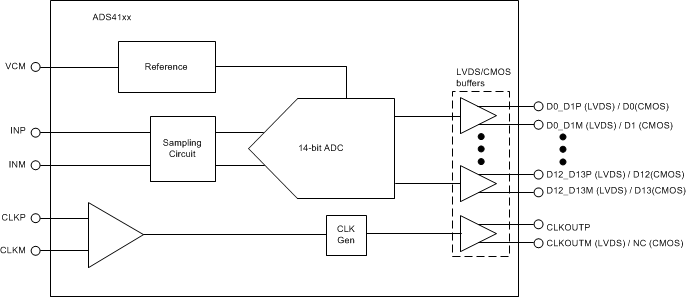ZHCS054C February 2011 – June 2017 ADS4122 , ADS4125 , ADS4142 , ADS4145
PRODUCTION DATA.
- 1 特性
- 2 应用
- 3 说明
- 4 修订历史记录
- 5 Device Family Comparison
- 6 Pin Configuration and Functions
-
7 Specifications
- 7.1 Absolute Maximum Ratings
- 7.2 ESD Ratings
- 7.3 Recommended Operating Conditions
- 7.4 Thermal Information
- 7.5 Electrical Characteristics: ADS412x
- 7.6 Electrical Characteristics: ADS414x
- 7.7 Electrical Characteristics: General
- 7.8 Digital Characteristics
- 7.9 Timing Requirements: LVDS and CMOS Modes
- 7.10 Serial Interface Timing Characteristics
- 7.11 Reset Timing Requirements
- 7.12 Timing Characteristics at Lower Sampling Frequencies
- 7.13 Typical Characteristics: ADS4122
- 7.14 Typical Characteristics: ADS4125
- 7.15 Typical Characteristics: ADS4142
- 7.16 Typical Characteristics: ADS4145
- 7.17 Typical Characteristics: Common
- 7.18 Typical Characteristics: Contour
- 8 Detailed Description
- 9 Application and Implementation
- 10Power Supply Recommendations
- 11Layout
- 12器件和文档支持
- 13机械、封装和可订购信息
1 特性
- 超低功耗,采用 1.8V 单电源:
- 65MSPS 时的总功耗为 103mW
- 125MSPS 时的总功耗为 153mW
- 高动态性能:
- 信噪比 (SNR):170MHz 时为 72.2dBFS
- 无杂散动态范围 (SFDR):170MHz 时为 81dBc
- 随采样速率动态地进行功率调节
- 空闲通道 SNR 74.8 dBFS (ADS414x)
- 输出接口:
- 支持可编程摆幅和强度的双倍数据速率 (DDR) LVDS:
- 标准摆幅:350mV
- 低摆幅:200mV
- 默认信号强度:100Ω 端接
- 2x 强度:50Ω 端接
- 还支持 1.8V 平行 CMOS 接口
- 支持可编程摆幅和强度的双倍数据速率 (DDR) LVDS:
- 用于 SNR、SFDR 权衡的最高 6dB 可编程增益
- 直流偏移校正
- 支持低至 200mVPP 的输入时钟幅度
3 说明
ADS412x 和 ADS414x 器件是 ADS41xx 系列模数转换器 (ADC) 中采样速度较低的型号。该器件凭借创新设计技术实现了高动态性能,并且采用 1.8V 电源供电运行,功耗极低。它们非常适合于多载波、高带宽通信 应用。
ADS412x 和 ADS414x 器件具有精细增益选项,可用于提升在较小满量程输入范围内的 SFDR 性能,特别是高输入频率条件下。这些器件包括一个 DC 偏移校正环路,可以用来消除 ADC 偏移。在较低的采样速率条件下,ADC 自动以低功耗运行,且没有性能损失。
ADS412x 和 ADS414x 器件采用紧凑型 VQFN-48 封装,额定温度涵盖了工业温度范围(–40°C 至 +85°C)。
器件信息(1)
| 器件型号 | 封装 | 封装尺寸(标称值) |
|---|---|---|
| ADS4122 | VQFN (48) | 7.00mm x 7.00mm |
| ADS4125 | ||
| ADS4142 | ||
| ADS4145 |
- 如需了解所有可用封装,请参阅产品说明书末尾的可订购产品附录。
